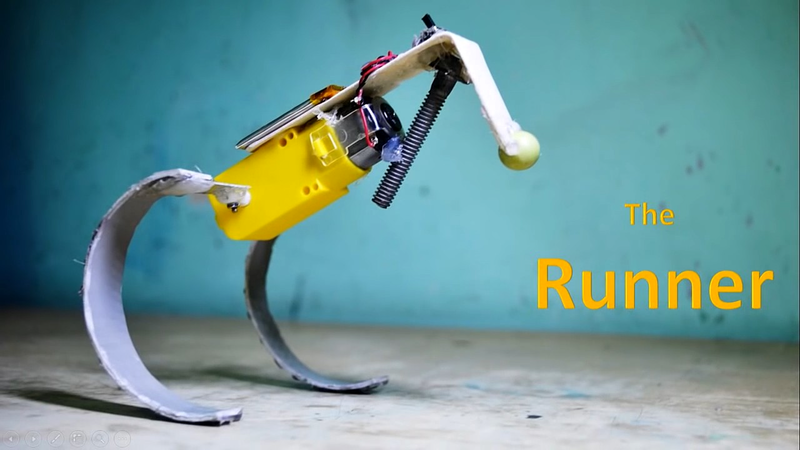One of the takeaway ideas that we got from BEAM robotics was the idea that the machine itself, rather than tons of processing power, can do a lot. Your hand affords gripping, and humans have made a pretty good living out of manipulating things (he says, typing). None of this is about the brain; it’s all about the mechanism.
Which brings us to the one-motor “Runner” robot. We’ll admit that we were a little bit disappointed to see that it doesn’t run so much as hop, flop, or scoot along on the two legs and that front wheel-nose. Still, it’s an awesome mechanism, and gets the locomotion job done in a very theatrical way. We’re left wondering if using two motors would allow it to steer or just flip over and flail around on its back. Going to a six “leg” design will definitely get the job done, as demonstrated by Boston Dynamics RHex robot.
Anyway, you’ve got no excuse for not making one of these. Check out the video below for further inspiration. And while you’re at it, have a look at Gyroman, another oddball single-motor mechanism. What’s your favorite?
















inb4 “not a hack”.
I’ll be dammed if that’s not hella fun, and a great project for kids.
this one can run for sure :)
https://www.youtube.com/watch?v=LTIpdtv_AK8
Thank you for that. :)
Someone should make a dodecahedron shaped version with either twelve or twenty legs…
Not really legs, just wheels with a discontinuous rim.
The “legs” don’t move backwards and forwards, bit spin around an axel just like any other wheels would do.
It’s amazing what a good publicity/cheerleding team can make people believe.
But it did give me a borderline crazy idea to attempt with air-actuated legs.
Funny, if you looks very similar to a spoked wheel without the rim and the shock absorbers are located in the spokes. Yet it is presented as a walking robot. Could someone please describe the rules that must be used in order to call something a “walking” robot. I find this very confusing.
not really much better than just a wheel…. but i sure enjoyed watching the assembly video. i haven’t seen such aggressive overuse of hot melt glue since the last time i watched myself work!
It doesn’t look like a kangaroo or move like one, but whatever it is it’s a clever idea.
How a kangaroo does actually move is very interesting because the tail is essential even though it does not touch the ground at high speed and the animals tendons store a large amount of energy from each landing to use with the next bound. But most of the time they are moving slowly and the mechanics are completely different.
The kangaroo’s tail propels and powers pentapedal locomotion.
http://rsbl.royalsocietypublishing.org/content/10/7/20140381
So why does this matter, because it is claimed that the kangaroo’s motion is the most efficient of all land animals and it’s conversion of feed (grass) to protein is also the most efficient. The fact that the bigger males can grab you by the ears and rip your guts out with a double down kick from their hind legs (while balancing on their tails) is actually the least impressive thing about them.
The Festo robot kangaroo sort-of moves like a real kangaroo, but it’s the result of a multi-million dollar research department.
https://www.youtube.com/watch?v=_4luJ0ZSqy8
They got the idea of the leg tendons right, but the real animal’s body acts like a big spring and the tail can also help them change direction rapidly.
If anyone was thinking I was exaggerating about their power, meet Roger,
https://www.youtube.com/watch?v=DFCvPrzj4BU
Both of these are very inaccurate.
At higher speeds a kangaroos front limbs never come near the ground. Balance is maintained by the tail and even though the rear tendons can store energy and keep the motion mostly horizontal, this is *not* what happens at higher speeds in the wild. These assessments are based on kangaroo’s what have lived in zoo’s and never developed the skills that wild kangaroo’s do.
And with the robotic kangaroo in the video lol it looks so funny because a wild kangaroo never turns on a spot. Kangaroos turn mid flight in a bound. It’s turning motion is then reflected as a directional transition at the beginning of it’s next bound. It’s odd to watch because it looks like an instantaneous change of direction that is so dramatic that it looks unnatural or not possible. It’s the mid flight preparations that make it possible.
In the wild, a stationary kangaroo can jump 30 feet or more in it’s first bound and it accelerates dramatically from there. Any the can jump practically straight up! as in “where the … did that go”
If I had a longbow I could bag a roo from a spot 3 meters from where I am sitting now. Not that I’d do that, because I don’t eat meat.
By that I mean I have to move 3 meters to see them and have them in range. They don’t get “that” close these days since the fence when up, but in the past they’d crap on my front lawn.
More funny-shaped wheels pretending to be legs: the “legs” just spin around an axis just like any other wheels would do, but provide a much less smooth ride in this case.
sure, fun project for kids. but i wonder what makes a robot.
To me this is a robot like the hand mixer in my kitchen or my
vacuum is a robot. they simple aren’t.
This is more a rc-less rc car.
I really ask myself now at what point is a (technical) device a robot,
where is the line?
any ideas?
michael